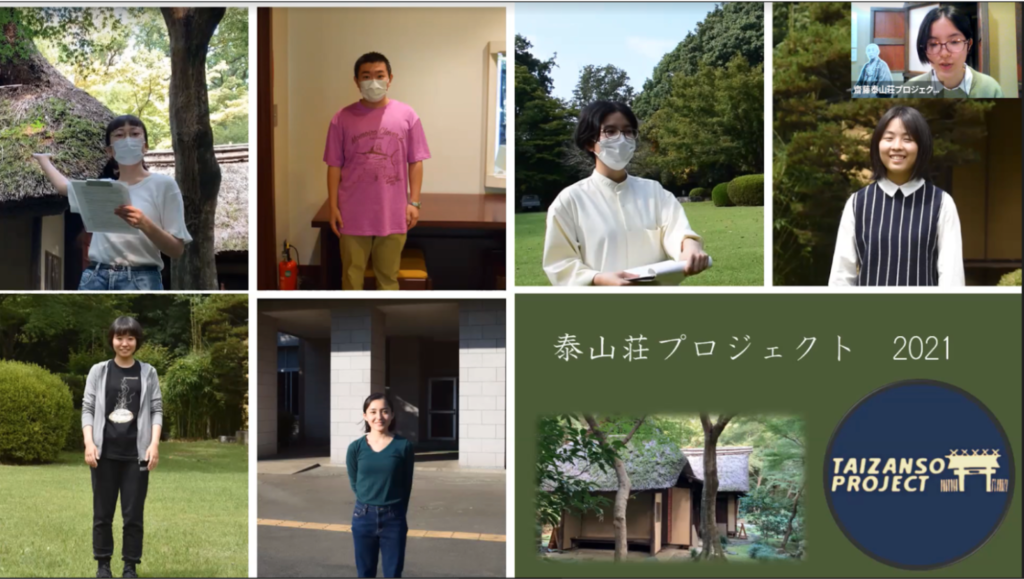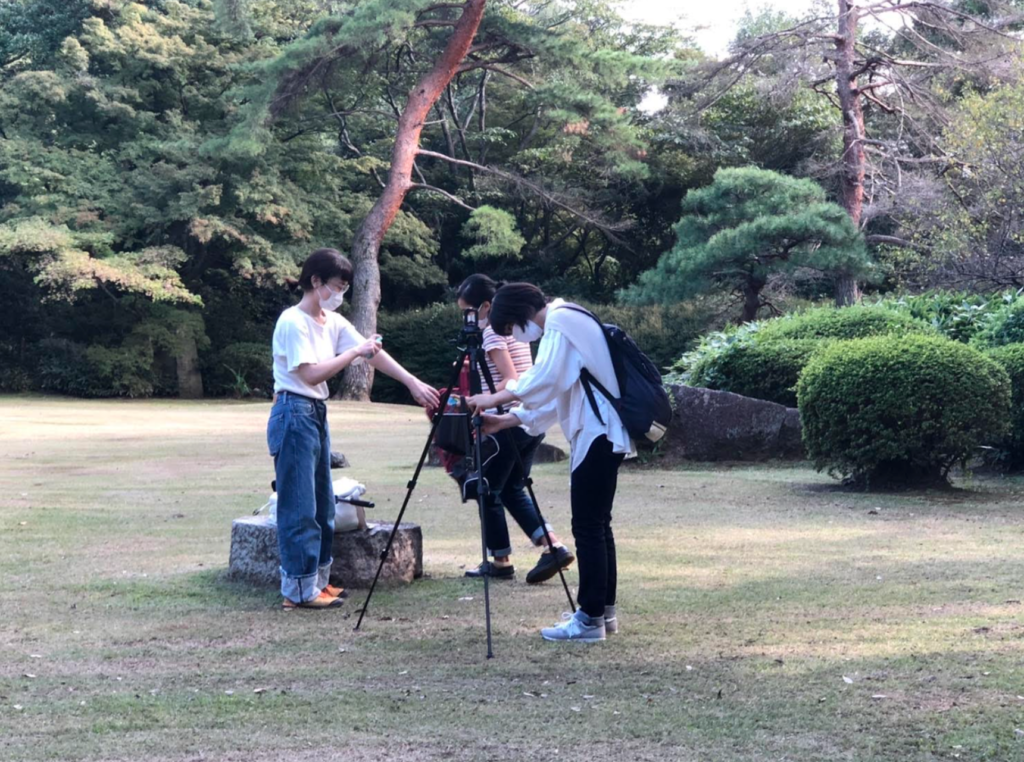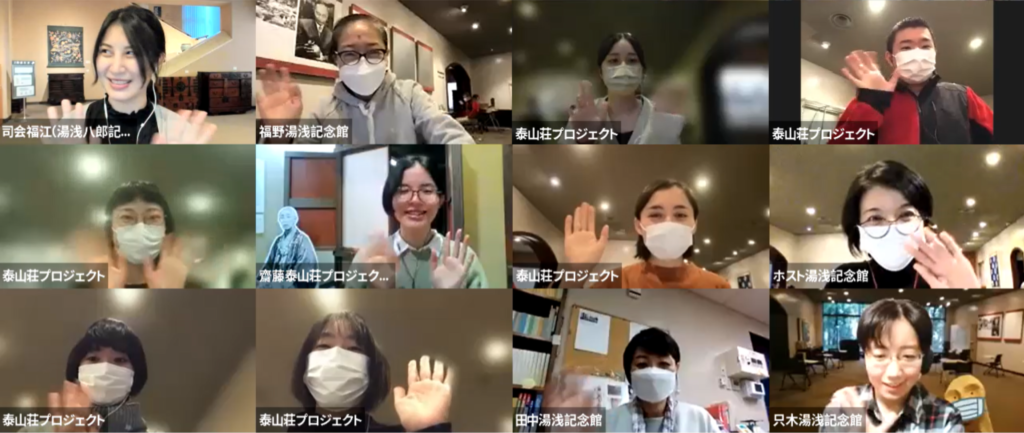Protecting and passing on the legacy of the past at a time when people tend to focus on the future – Interview with members of the ICU Taizanso Project
In our 25th interview, we interviewed four members of the ICU Taizanso Project, a student group that works to preserve the tangible cultural property, Taizanso, owned by ICU. You can feel their passion and enthusiasm for Taizanso from every word they say. They talked about everything from basic information about Taizanso to the significance of students protecting cultural property, so please take a look!
Q1. What is Taizanso all about?
Miss. Goi Taizansō is a registered tangible cultural property located behind the Gakki (university cafeteria). It currently consists of a group of six buildings, all of which areregistered as cultural properties since 1999.
We are engaged in three main activities: preservation, raise awareness, and the utilization of Taizansō. In the past, we held an event called “Yūbe at Taizansō” and also held an open house during the ICU Festival in conjunction with Tokyo Heritage Week, where we served as tour guides.
___Please tell us about the buildings’ history and their origin.
Miss. Goi There is a building called Kōfūkyo, and in one of its rooms there is a one-mat room study called Ichijōjiki. This is where Takeshirō Matsuura, the godfather of Hokkaido, built it, and it is considered to be of great historical value. Takeshirō Matsuura customized old materials from famous places throughout Japan to create wondrous spaces, and the Ichijōjiki is one of them. Although originally located in Kanda, through several relocations, Ichijōjiki and the entire building, Kōfūkyo, eventually settled in Mitaka. Keisuke Yamada, a businessman created Taizansōto host his tea parties. Kōfūkyo was designated the main grounds. Later, Nakajima Aircraft Company (SUBARU Co., LTD.) bought Kōfūkyo before ICU did—currently, ICU owns Kōfūkyo. Alongside Taizansō Project, the Tea Ceremony Club uses Taizansō.
___Why did ICU take ownership of it?
Mr. Sakamoto It was only “there” when ICU bought the land. I don’t think ICU took much consideration about it at that time.

Q2. What specific activities are you engaged in?
Miss. Saito We held events in the form of using Taizansō, such as having a rakugo performance. Before COVID, we had Japanese cultural groups organizations such as Wadaiko (Japanese drums) performers, Japanese dancers, and Nagauta singers give events.
___How is cleaning done?
Miss. Goi Because buildings are made of wood, moisture can cause mold growth and aging. Therefore, it is important to keep the building well-ventilated in order to protect it. All doors are opened, tatami mats are swept, cobwebs are cleared, and brooms are swept around the building. We work during lunch breaks and clean for 30-40 minutes.
Q3. When did this activity start?
Miss. Goi In 2000, the Taizansō project was launched by several volunteers from the tea ceremony club. At that time, 20 years had passed since the large-scale restoration of Taizansō (the 1970s-80s), and the building was deteriorating, with the thatched roof of the Kōfūkyo covered by a tin roof to prevent rain leaks. The Taizansō project was initiated by students at the time who were concerned about this and began their activities by cleaning the tearoom.
___Please tell us about the tearoom.
Miss. Goi The entire Taizansō is dedicated to tea ceremonies, with the Kōfūkyo being the so-called “tea room.” There is also a waiting area and other facilities, and the tea ceremony is completed by walking across the building.
Q4. What made the current members decide to start their activities?
Miss. Goi I originally knew about the Taizansō itself and the Taizansō project, but it was a class in the curatorial coursethat directly sparked my interest in the place. I loved it when I visited Taizansō for the first time there, and I thought that if I participated in the activities of the Taizansō Project, I would be able to visit and observe it up close many times.
Miss. Saito When I first entered the school, my sister, who was then the head of the Taizansō Project, invited me to join the club because they were short on staff. I was just thinking about getting a curatorial license, so it was a good match for me. It was not my intention from the beginning, but I am very glad I joined.
Miss. Saito I learned about Taizansō and the Taizansō Project by participating in an online Tsukimi event. While I was very surprised that a student could be involved in such an activity, I decided to get involved because I had been interested in archaeology since before I entered university.
Mr. Sakamoto I researched Takeshirō Matsuura in my history class, visited the Hachiro Yuasa Memorial Museum, and was attracted to Ichijōjiki that Takeshirō Matsuura had created, and knew I wanted to get involved.
Q5. How did you feel when you started out?
Miss. Goi The first was that I was thrilled to see the Ichijōjiki up close.
Miss. Saito I remember wondering about the strangeness of being able to enter a cultural property with ease.
Miss. Saito I was intrigued to see that the Taizansō is very well kept.
Q6. When do you feel motivated?
Miss. Goi It is rewarding when we feel that we are conservation leaders in the cleanup and when people who are interested in Taizansō join our project. We are happy when some students show their interest through online hanami and brief introductions, despite not many people recognizing our group. We also have some big fans who come to our public open house, and it is gratifying to have them involved with Taizansō in that way.
Miss Saito In 2018-19, as part of the project’s activities, we held guided tours (hosted by the Hachiro Yuasa Memorial Museum) which had approximately 300 attendees; it was very rewarding when many of the attendees told us that the tour was fascinating. We accepted reservations for the tour only on a lottery or invitation basis, so some people said, “I finally got this! We also had the opportunity to learn from those who were knowledgeable about the area. Also, it feels great when I open the high wind storm shutters during cleaning and let light and airflow into the rooms.
Miss Saito I am ID24, and due to the spread of COVID-19, I have not been able to participate in many activities since I joined the club. Last year, I created a video introducing Taizansō, which was my first experience working on a major project with all the members. This video was shown at a webinar hosted by the Hachiro Yuasa Memorial Museum, and I thought it was rewarding.

Q7. What do you think is the significance of student groups protecting cultural properties?
Miss Goi While society as a whole is in the midst of a strong trend to abandon the old and praise the new, laws were enacted to protect cultural properties based on the idea of preserving culturally valuable items for future generations, and Taizansō was designated as a tangible cultural property in 1999. However, the government cannot maintain every single property; it is the responsibility of those who own it. That is not a difficult task.In fact, some of the buildings of Taizansō were destroyed by fire in the past before it was designated a cultural property. Suffice to say, this was also due to a lack of awareness on the part of the university and a lack of attention to management. Due to the structure of the university, the same people cannot manage the buildings all the time, and we need to find people who can protect the Kofukyo after we are gone. In this sense, I think it is significant to create the tradition of students protecting cultural properties.
Q8: Are there any difficulties in your activities?
Miss. Goi There are difficulties in taking on the responsibility of protecting cultural properties as a student organization with study abroad and long vacations. As a college, students go in and out, meaning there is not a specified amount of individuals in the project. Therefore, although it would be ideal to clean the site every day, the reality is that we can only do so once a month, and during the period when a state of emergency was declared, the cleaning itself could not be carried out.
________ After a prolonged declaration of a state of emergency, did the condition still deteriorate?
Miss. Saito While we could not enter the campus, staff members kept an eye on the area, so fortunately the only problem was that there was a beehive. However, the contractors who normally take care of the trees were not allowed in, so the trees were overgrown. Of course, we were not able to work during the time of priority measures to prevent the spread of COVID-19, and I think it could be said that being a student backfired in a sense. However, because we are a student organization that is constantly changing, the fact that the environment surrounding Taizansō itself is changing means that there are more opportunities for us to be seen by various people, so I think there are both positive and negative aspects.
Q9. What have you learned or realized through your activities?
Miss. Goi The staff of Hachirou Yuasa Memorial Museum said “I want you to know about Taizansō, but there are security issues.” If we explain in detail the route to Taizansō and its location, we increase the risk of exposure to danger from a security standpoint, since we do not know who might enter the building. The balance between utilization and publicity is a problem that we and the university always face. Even simple tasks such as uploading photos on social media requires permissions from a multitude of different individuals, which is difficult compared to other clubs or groups.
Miss. Saito We are aware of how quickly culture and objects are lost when people lose interest and abandon them. At Taizansō, the main building was destroyed by fire before people became aware of the need to preserve it, and valuable wood was exposed to damage from insects. Especially in a fast-metabolizing community such as a university, we believe it is necessary to be conscious of the need to connect our thoughts and feelings.
If you are interested in learning more about Taizansō, please visit the Hachiro Yuasa Memorial Museum on ICU’s campus.

Q10. What is your message towards society?
Miss. Saito I think the current trend is space research and future technology. While everyone is looking up at the sky, the deep sea is also an unknown world to us. In the same way, it is important to invest in future technologies. However, I think that we do not know as much about the past as we do about the future, such as how people in the past lived, what kind of diversity they were born and died in, and how they built their lives and environment.
I study history, and what I found is that once something is lost, it can never return, and that is why we cannot see the past, just as we cannot see the future. However, unlike the inability to see the future, the past has cultures, objects, and words left behind by people in the past. In such objects with history, there are keys left behind that can unlock the ideas by which people in the past lived, or live today. Thinking about and trying to understand people living in the past leads to thinking and realizing the diversity of human existence. In this aspect, cultural properties are very important. However, objects and cultures that have passed out of human hands and the backgrounds in which they were nurtured are being lost at a breakneck speed. That is why it is important to preserve cultural properties. By preserving them, they can become the way of us today, a place that is our emotional support, a place to confirm our ties.
We do not decide how to use them, but when we ask people how they would like to use them, we believe it is our job to preserve them as “objects”. Therefore, I always think that “please don’t destroy old buildings!” It is not an appeal to society, but a request.
Miss. Goi Firstly, I would like to let everyone at ICU (not only students, but also teachers and staff) know that there is a nationally registered tangible cultural property called Taizansō on campus, and that inside it is a very strange and interesting space called Ichijōjiki. “Weathering” seems to begin not only with physical decay but also with people’s loss of interest and its fading from memory. Even activities as small as the cleanup of the Taizansō Project are helping to ensure that the cultural resources we enjoy today will be passed on to the future. It is not easy to ensure that the connection between cultural properties and people will not be severed, but I hope that awareness of this issue, as well as its importance, will spread.
___Are there any organizations at other universities that own and preserve cultural properties? And are there opportunities to contact organizations at other universities?
Miss. Saito Basically, this organization works independently. For example, at the University of Tokyo, various buildings are things that have left their names in the history of Japanese education or have been moved from somewhere else. So, I don’t think it is that special for a university to have cultural properties.
Personally, I would strongly suggest the point of imbalance that ICU, a Christian university built on land that was confiscated by GHQ, has buildings that have been since the Edo period, which are completely unrelated to the university. In many cases, the things at the University of Tokyo are incorporated into the roots of the University of Tokyo, and are often preserved in the sense that they are buildings that are essential to the history of the individual universities that they have. But ICU doesn’t have that many pre war structures. There is a very large one, the Nakajima Aircraft Research Institute, but the only structure that predates the institute can be found at Taizansō. Taizansō has a different independent history from ICU.

Q11. Please tell us your plans next and what you would like to challenge yourself!
Miss. Saito We would like to conduct regular guided tours and hold a contest and exhibition of artwork using Taizansō as a motif.
Miss. Goi I mentioned earlier that preservation, publicity, and utilization are the three pillars of our activities, but this year, compared to last year, the requirements for gathering have become much less stringent, and it is a little easier to get together with people. I would like to do something to the extent I can to promote awareness and utilization of the activities that were previously focused on conservation. We are planning to conduct publicity activities like this interview to make Taizansō and our organization is known to the public, hold study sessions in cooperation with other organizations, and hold events using Taizansō.
Also, if we can let teachers know that it is possible to use Taizansō for classes, we can expect to receive money and human resources for the conservation and utilization of Taizansō. We would also like to create a system whereby the university can make a request when it is difficult for students to carry out cleanups on their own.
Books and Movies recommended by Taizansō project members to ICU students
・ICU Hachiro Yuasa Memorial Museum (Ed.). (2018). The One-Mat Room Matsuura Takeshirō’s Private Study. International Christian University Hachiro Yuasa Memorial Museum.
…The extensive use of photographs of the site will give you a more realistic impression of the atmosphere of the Ichijōjiki. Recommended as an introductory book.
・Henry D. Smith II. (Author), J. Edward Kidder Jr (Ed.), Reiko Hara (Ed.), Akiko Fukuno (Ed.). (1993). Taizansō and the One-Mat Room. International Christian University Hachiro Yuasa Memorial Museum.
…It details how Taishanso came to be owned by ICU, the individual buildings, and the source of the old lumber for Ichijōjiki. This is a must-read if you want to learn more about Taizansō as a whole.
These are available in ICU library and for sale at ICU Hachiro Yuasa Memorial Museum(ICU students can purchase them at a discount).
[ICU 泰山荘プロジェクトのウェブサイト、SNSアカウント]
Website:泰山荘紹介サイト
Instagram:@icu.taizansoproject
Twitter:@taizansoproject